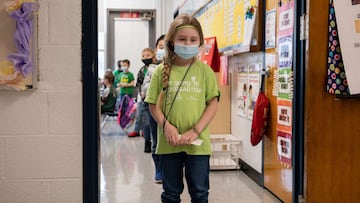What are new CDC guidelines for schools?
The Centers for Disease Control and Prevention (CDC) has made changes to its operational strategy to protect primary and secondary (K-12) school children during the pandemic.

Primary and secondary (K-12) schools have been ordered to open in four states (Arkansas, Texas, Iowa and Florida), are partially closed in California, Delaware, District of Columbia, Hawaii, West Virginia and New Mexico with full closure only in effect in Puerto Rico, although pupils in the 1st, 2nd, 3rd, and 12th grades will be allowed to return to classes for two days a week later this month.
IRS backlog could delay Child Tax Credits
Will there be a fourth stimulus check?
Schools reopening in the US
As for everywhere else in the US, school districts in each state have been left to decide if and when to reopen buildings although most are encouraging a combination of in-person and remote learning throughout the 2020-21 academic year. Districts have mapped out their own safety guidelines and protocol for the reopening of schools, such as wearing masks, Covid-19 testing, social distancing, monitoring and screening for Covid-19 symptoms and vaccination of staff.
According to World Health Organization (WHO) data, children under the age of 18 years represent about 8.5% of the total reported cases of Covid-19 infection, with relatively few deaths compared to other age groups and usually mild disease. However, cases of critical illness have been reported. Pre-existing medical conditions have been suggested as a risk factor for severe disease and intensive care admission in children.
With schools already open or set to reopen, the Centers for Disease Control and Prevention (CDC) has outlined its operational strategy to protect K-12 schoolchildren during the pandemic. K-12 schools that have strictly implemented prevention strategies have been able to safely open for in-person instruction.
Under the CDC's revised recommendations, pupils must respect social distancing and will be able to sit at least 3 feet apart from each other inside the classroom as long as they are wearing masks. They must be kept 6 feet away from one another during sporting events, assembly, lunch, field trips or other group activities when masks cannot be worn.
The CDC has removed its previous recommendation for physical barriers such as partitions and sneeze guards – these are no longer necessary which means that there is room for more children in the classroom. The CDC explain that there is no evidence that physical barriers are effective.
Ventilation and disinfecting classrooms
An important component of the safety strategy should be to ensure that all indoors areas should be well ventilated (doors and windows opened when weather conditions allow) and regularly cleaned and disinfected. Pets that are at higher risk for infection with the virus that causes Covid-19 such as cats, dogs, and small mammals like ferrets, hamsters, and rabbits should not be allowed in the classroom.
Teachers and other adults should continue to stay 6 feet from one another and from students.
Staff or students who are ill or who have recently had close contact (less than 6 feet for a cumulative total of 15 minutes or more over a period of 24 hours or direct physical contact) with a person with Covid-19 should be actively encouraged to stay at home and get tested for Covid-19.
Face masks recommended for schoolchildren
Masks are strongly recommended in most cases apart from special cases - such as children younger than 2 years old, anyone who has trouble breathing or is unconscious or anyone who is incapacitated or otherwise unable to remove the mask without assistance. Masks are required on school buses and other forms of public transportation.
If possible, have children eat their school meals outdoors or in well-ventilated areas, while maintaining physical distance of at least 6 feet apart while unmasked.
Parents or child carers are strongly encouraged to monitor their children for signs of infectious illness including Covid-19 every day.
Covid-19 protection plan of action
Schools should also be prepared for when students, teachers, or staff show symptoms of Covid-19 or are diagnosed with Covid-19. Students, teachers, and staff who have been close contacts (within 6 feet for a cumulative total of 15 minutes or more over a period of 24 hours) of someone with Covid-19 should not return to in-person school until they have completed a 14-day quarantine. Health officials and close contacts should be immediately notified.





